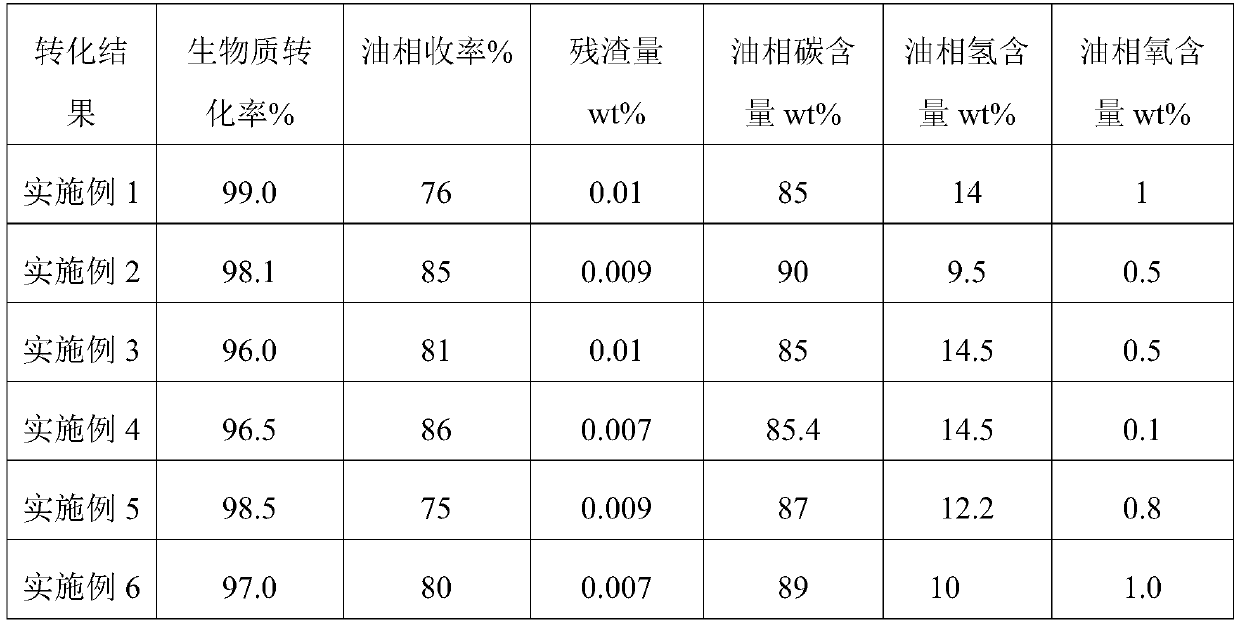A multi-stage liquefaction process of biomass
A biomass and process technology, applied in the field of biomass multi-stage liquefaction process, can solve the problems of unstable transportation, high energy consumption, and low pump-to-biomass transportation volume, and achieve volume reduction, industrial cost and energy consumption reduction. , to achieve the effect of smooth operation and transportation
- Summary
- Abstract
- Description
- Claims
- Application Information
AI Technical Summary
Problems solved by technology
Method used
Image
Examples
Embodiment 1
[0058] A multi-stage liquefaction process for biomass, comprising the steps of:
[0059] Biomass Pretreatment
[0060] Put the palm oil residue into the drier and dry at 80°C for 6h until the water content is lower than 2wt%, and then send it into the superfine pulverizer for primary crushing. The median particle size after primary crushing is 100 μm, and then the primary crushing The palm oil residue is sent to the plodder for compression extrusion molding at a temperature of 40 °C and a pressure of 5 MPa, and then for secondary crushing. The median particle size after secondary crushing is 30 μm. The bulk density of the final palm oil residue is 1600kg / m 3 ,spare.
[0061] Preparation of the first catalyst
[0062] (1) taking biochar as the first biochar carrier;
[0063] (2) loading iron oxide on the above-mentioned first biomass charcoal carrier, and performing sulfuration treatment to prepare the first catalyst.
[0064] The concrete method that iron oxide is load...
Embodiment 2
[0079] A multi-stage liquefaction process for biomass, comprising the steps of:
[0080] Biomass Pretreatment
[0081] Send the linseed oil residue and peanut oil residue into a drier and dry at 110°C for 2 hours until the water content is lower than 2wt%, and then send them into an ultrafine pulverizer for primary crushing. The median particle size after primary crushing is 300 μm, and then The primary crushed linseed oil residue and peanut oil residue are sent to the plodder for compression extrusion molding at a temperature of 60°C and a pressure of 3 MPa, and then secondary crushing, the median particle size after secondary crushing is 50 μm, The bulk density of linseed oil residue and peanut oil residue after secondary crushing is 1500kg / m 3 ,spare.
[0082] Preparation of the first catalyst
[0083] (1) taking biochar as the first biochar carrier;
[0084] (2) Loading iron oxyhydroxide on the above-mentioned first biomass charcoal carrier, and performing sulfurati...
Embodiment 3
[0100] A multi-stage liquefaction process for biomass, comprising the steps of:
[0101] Biomass Pretreatment
[0102] Put saponin oil residue and rapeseed oil residue into a drier, dry at 100°C for 3 hours until the water content is lower than 2wt%, and then send them into an ultrafine pulverizer for primary crushing. The median particle size after primary crushing is 200 μm, Then the saponin oil residue and rapeseed oil residue after primary crushing are sent to a briquetting machine for compression extrusion molding at a temperature of 50°C and a pressure of 4MPa, and then secondary crushing is carried out. The particle size is 40μm, and the bulk density of saponin oil residue and rapeseed oil residue after secondary crushing is 1560kg / m 3 ,spare.
[0103] Preparation of the first catalyst
[0104] (1) taking biochar as the first biochar carrier;
[0105] (2) Loading iron hydroxide and iron oxide on the above-mentioned first biomass charcoal carrier, and performing s...
PUM
| Property | Measurement | Unit |
|---|---|---|
| density | aaaaa | aaaaa |
| particle diameter | aaaaa | aaaaa |
| particle diameter | aaaaa | aaaaa |
Abstract
Description
Claims
Application Information
 Login to View More
Login to View More - R&D
- Intellectual Property
- Life Sciences
- Materials
- Tech Scout
- Unparalleled Data Quality
- Higher Quality Content
- 60% Fewer Hallucinations
Browse by: Latest US Patents, China's latest patents, Technical Efficacy Thesaurus, Application Domain, Technology Topic, Popular Technical Reports.
© 2025 PatSnap. All rights reserved.Legal|Privacy policy|Modern Slavery Act Transparency Statement|Sitemap|About US| Contact US: help@patsnap.com


